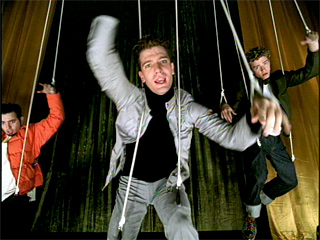You are here
Using Music Videos to Explore Historiography
Primary tabs

This assignment encourges students to think about how they can read and piece together primary sources to create a descriptive narrative. Students are asked to pair together Steven Horowitz's useful Billboard article "The Boys! Are Back in Town," (Billboard 124.11 (2012): 24-29) and three music videos: 'N Sync's "Bye Bye Bye," One Direction's "What Makes You Beautiful," and The Wanted's "Glad You Came" in order to construct a history of "the boy band" as a class.
This lesson plan should help students practice
- observing characteristics of historical narrative in the example article.
- employing primary sources in order to construct their own historical narratives.
- visual analysis. This helps prepare students for more rigorous analysis later in the semester.
- genre analysis. This helps students understand how to describe boundaries for celebrity groups and construct their own definitions of key terms in the realm of celebrity.
This activity is discussion-based, though students may opt to take notes for reference during the larger discussion.
In Unit 1 of my class, The Rhetoric of Celebrity, I require my students to construct a historical account of a specific area of celebrity of interest to them. Throughout this unit, we practice descriptive modes of discourse oriented around the conventions of historiography. The goal of Unit 1 is to encourage students to recognize how different sources construct histories of people, places, and events by employing several key historiographical conventions: designating points of origin; describing the composition of groups, genres, or movements; tracing historical trajectory/historical narrative; addressing concerns of taste and cultural register; and positing possible future trajectories.
I begin class by handing out Horowitz's article and asking the students to read it. After students finish reading, we spend a few minutes summing up Horowitz's main argument. I ask them to identify elements of the article that they think make it "historical" in terms of the rhetoric it employs. If the students struggle to accomplish this, I bring up the Essay 1 prompt and remind them of the requirements of their own history writing project--Where do boy bands begin? What are some examples of boy bands? What constitutes a boy band? How do media and technology influence the development of the genre? What trajectories can we identify? How can we fit boy bands into high or low culture? What is the future of boy bands? Then we discuss how Horowitz has answered these questions, and how we might use primary sources to substantiate, contest, or expand Horowitz's claims.
I then show, in chronological order, three music videos: 'N Sync's "Bye Bye Bye," One Direction's "What Makes You Beautiful," and The Wanted's "Glad You Came". I ask the students to address the genre of boy band celebrity and identify commonalities and differences between the three pieces. We start with commonalities:
- How can we define a boy band using these three sources?
- What elements do all the "boys" share? (clothing style, hair style, choreography, distinct personalities, indistinct personalities?)
- Who else could we add to our list of boy bands?
- Who wouldn't fit under the heading of boy band?
- What can audience reception lend to our definition?
Then, we move on to differences.
- How are the three bands different?
- How have the image of the boy band changed over time?
- What influence does cultural register/taste have on boy bands' presentation over time?
- How might boy bands exist in the future?
Finally, I ask students to construct their own abbreviated "history" of boy bands in groups to share with the class, using one additional video source to substantiate their claims. The additional source could be omitted for non-technology-enabled classrooms.
Instructors might read the article, watch the videos, and think of leading questions to propel discussion if student should have trouble getting started. Once a student articulates a few ideas, in my experience, the discussion is generally lively.
Students should take notes on the historical elements of the article, as well as on some formal elements of the music videos, to help them generate specific points of reference during in-class discussion.
In general, student presentations at the end of class indicate how well students can both identify and employ the historical elements we are examining in Unit 1. I like to walk around during group work in order to informally evaluate brainstorming/invention at this level, as well.
Although it embarrasses students a little to watch Boy Band videos, this lesson plan has in the past been a fairly foolproof way to engage them in both descriptive rhetorical practice and analysis of descriptive rhetoric. Almost everyone participates in the larger discussion, and the informal student presentations at the end of class are generally of good quality considering the amount of time devoted to them.
This lesson plan can easily be applied to any descriptive unit that wants to tackle the rhetoric of a particular historiography by merely swapping out the sources. If the sources are from the realm of popular culture, students seem particularly able to grasp somewhat complex rhetorical concepts and apply them to other spheres.
I teach the Rhetoric of Celebrity, which I break down into three units. Unit 1 deals with descriptive writing; Unit 2 deals with analytical writing; Unit 3 deals with evaluative or critical writing. The activity above is useful for Unit 1, although I try to introduce skills in each unit that will ease students' transitions between these three modes.
-

- Log in to post comments

